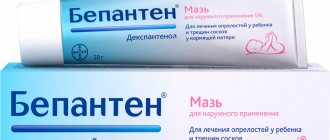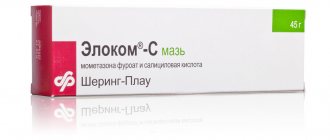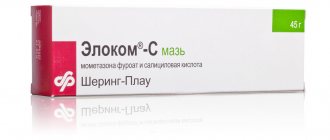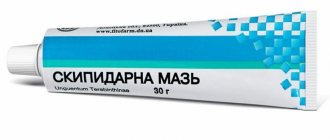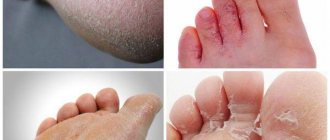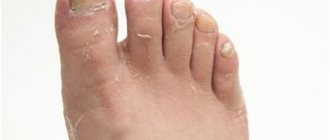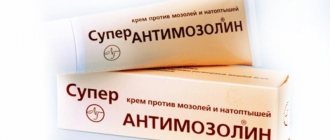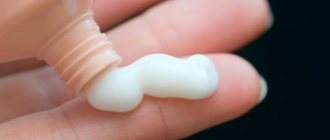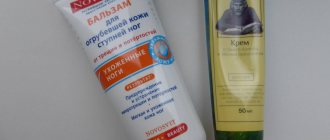Dosage form, composition of the drug
The active substance of the ointment is retinol palmitate, a form of vitamin A that has a rapid, targeted therapeutic effect. In terms of effectiveness, this compound is comparable to glucocorticoid hormones, as it is involved in most recovery processes. Videstim contains 0.5% pure retinol palmitate, emulsion wax, ethyl alcohol, glycerin, petroleum jelly, water, stabilizing additives.
The drug is a homogeneous thick mass of cream or light yellow color. Easily spreads over the skin and is absorbed. We see it is packaged in tubes weighing 10 and 35 g and cardboard boxes with instructions included.
Mechanism of action of the drug
Vitamin A has an anti-inflammatory and regenerating effect, prevents excessive growth of epithelial tissue of the skin and mucous membranes, improves cell nutrition, accelerates the healing of damage, regulates desquamation and redox processes. Most of the vitamin comes from food and is deposited in adipose tissue. Due to the pronounced medicinal properties of retinoids, systemic and local medications are produced on their basis.
Videstim ointment contains retinol palmitate, which binds to tissue cells using special receptors and directly affects them. As a result of use, the surface of the integument is leveled, inflammation and irritation are reduced. The active substance quickly penetrates into the deep layers, part of it is absorbed through the capillaries into the general bloodstream. On the surface of the skin, the ointment forms a protective film that protects inflamed areas from the effects of external negative factors.
The effect of the drug lasts for about 8–12 hours: pain and redness are reduced, the affected tissues gradually exfoliate, the development of hyperkeratosis and scar formation are prevented. Efficiency increases throughout the course of therapy. Penetrating into the body, retinol acts similarly to other forms of vitamin A: it takes part in metabolic processes, is deposited and metabolized in the liver.
We see ointment (treatment of cracked palms and feet) (tube 35g)
A country
Russia
The country of production may vary depending on the batch of goods. Please check with the operator for detailed information when confirming your order.
Active substance
Retinol
Compound
The active substance is retinol.
pharmachologic effect
It replenishes the deficiency of vitamin A. Having a large number of unsaturated bonds, it activates redox processes, stimulates the synthesis of purine and pyrimidine bases, participates in the energy supply of metabolism, creating favorable conditions for the synthesis of ATP. It is unevenly distributed in the body: the largest amount is in the liver and retina, less – in the kidneys, heart, fat depots, lungs, lactating mammary glands, adrenal glands and other endocrine glands. The predominant form of deposit is retinol palmitate, its reserves are slowly but constantly renewed. In tissues, retinol is localized predominantly in the microsomal fraction, mitochondria, lysosomes, and in the membranes of cells and organelles. Retinol, retinal, retinoic acid are secreted by hepatocytes in the bile, retinoyl glucuronide is excreted in the urine. Elimination of retinol is slow, so repeated doses lead to accumulation and adverse effects persist for a long time. Increases protein synthesis in cartilage and bone tissue, which determines the growth of bones and cartilage in length. Stimulates epithelization and prevents excessive keratinization of the epithelium (hyperkeratosis). Increases the number of mitoses in epithelial cells, prevents the accumulation of keratohyalin in them, promotes the synthesis of RNA and sulfated mucopolysaccharides, which play an important role in the permeability of cellular, subcellular and especially lysosomal membranes. Regulates the biosynthesis of glycoproteins of cell surface membranes, which determine the level of cell differentiation processes. Regulates the normal function of single-layer squamous epithelium, which plays a barrier role, and increases the body's resistance to infection. Strengthens the formation of antibodies and activates phagocytosis. Affects photoreception by participating in the formation of visual purple. Simulates the synthesis of hormones of the adrenal cortex. Inhibits the liberation of thyroxine. Ensures normal activity of the sebaceous and sweat glands.
Indications for use
Hypovitaminosis and vitamin A deficiency, infectious diseases (measles, dysentery, tracheitis, bronchitis, pneumonia), skin diseases (burns, frostbite, wounds, skin tuberculosis, hyperkeratosis, ichthyosis, psoriasis, pyoderma, some forms of eczema and other inflammatory and degenerative pathological processes) , eye diseases (retinitis pigmentosa, hemeralopia, xerophthalmia, keratomalacia, eczematous lesions of the eyelids, conjunctivitis), rickets, malnutrition, acute respiratory diseases, chronic bronchopulmonary diseases, erosive-ulcerative and inflammatory lesions of the gastrointestinal tract, cirrhosis of the liver, epithelial tumors and leukemia (to increase resistance of hematopoietic tissue to the action of cytostatics), mastopathy.
Mode of application
Externally. Apply a thin layer to the affected areas of the skin in the morning and evening, with severe peeling of the skin - under an occlusive dressing; burns, erosions, ulcers, cracks and wounds are treated with an antiseptic before application. The duration of treatment depends on the nature of the disease and is 4-12 weeks.
Interaction
The effect is enhanced by tocopherol and its preparations. Reduces (mutually) the risk of hypervitaminosis D. The absorption of retinol is disrupted by nitrites and cholestyramine.
Side effect
Headache, lethargy, nausea, vomiting, fever, drowsiness, peeling of the skin, gait disorders, pain in the bones of the lower extremities, hypervitaminosis A. In children, fever, drowsiness, sweating, vomiting, skin rashes, increased cerebrospinal fluid pressure (in children) Infancy may develop hydrocephalus and protrusion of the fontanelle). With intramuscular injections, local pain and the formation of infiltrates are possible.
Contraindications
Hypersensitivity, cholelithiasis, chronic pancreatitis, pregnancy (first trimester). Restrictions on use: acute and chronic nephritis, cardiac decompensation.
Overdose
In acute hypervitaminosis - severe headache, dizziness, drowsiness, confusion, blurred vision, convulsions, uncontrollable vomiting, profuse diarrhea, severe dehydration; on the second day a widespread rash appears, followed by large-plate peeling, starting from the face; palpation of long tubular bones is sharply painful due to subperiosteal hemorrhages, changes in bone, and soft tissues. In children, acute hypervitaminosis is characterized by anxiety, excitement, insomnia during the first day, sometimes drowsiness, fever up to 39°C, vomiting, protrusion of the large fontanel, signs of suffocation. Treatment: symptomatic; Thyroxine and ascorbic acid are prescribed as an antagonist.
special instructions
The teratogenic effect of increased doses of retinol persists even after stopping its use, therefore it is recommended to plan pregnancy when using the drug only after 6-12 months.
Indications for use
Videstim is used topically for skin lesions:
- for acne;
- dermatitis, eczema, dermatoses;
- cheilitis;
- cracks and damage;
- with excessive keratinization and its consequences.
According to reviews, Videstim helps eliminate signs of early aging and age-related changes in facial skin: relieves dryness, dehydration, restores turgor, smoothes wrinkles. In nursing mothers, the ointment prevents the development and promotes healing of cracked nipples. In adolescents, it stimulates cell renewal processes, reduces sebum secretion, and fights inflammatory elements. We see it has a beneficial effect on the integument during furunculosis.
Side effects and contraindications
During treatment with Videstim ointment, in some cases, increased irritation, itching and redness of the skin may occur. Typically, such symptoms appear in the first few days, then gradually disappear. This feature is explained by the property of retinol to activate metabolic processes in tissues.
- It is necessary to stop using the drug if you have an allergic reaction: increasing burning sensation, swelling, rash at the application sites.
- It is not recommended to use Videstim for open bleeding lesions, malignant neoplasms, or infectious inflammatory processes.
- Pregnant women are allowed to use the ointment according to individual indications, if the benefits of the product outweigh the likely risk to the health of the child.
The use of the drug can be dangerous in case of hypervitaminosis A. This is a fairly rare condition, but it can cause intoxication, so it is important to exclude it.
Registration number:
P N001403/01
Tradename:
Videstim®
International nonproprietary name:
retinol
Dosage form:
ointment for external use.
Compound:
- active ingredient:
retinol palmitate (Vitamin A) (100% equivalent) – 5 mg; - excipients:
butylated hydroxytoluene – 0.5 mg, butylated hydroxyanisole – 0.25 mg, emulsion wax – 80 mg, liquid paraffin (vaseline oil) – 80 mg, glycerol (glycerin) – 100 mg, ethanol (ethyl alcohol) 95% – 100 mg, purified water – up to 1 g.
Description:
homogeneous ointment from white to light yellow.
Pharmacotherapeutic group:
vitamin.
ATX code (D10AD02).
Pharmacological properties
Videstim® stimulates skin regeneration, enhances the reproduction of epithelial skin cells, inhibits keratinization processes, and prevents the development of hyperkeratosis. The local effect is due to the presence of specific retinol-binding receptors on the surface of epithelial cells.
Pharmacokinetics
Videstim® easily penetrates the skin, the maximum concentration in the blood is reached 3-4 hours after application and remains for 12 hours. The half-life is 5.5 hours.
Indications for use
Inflammatory diseases and skin conditions accompanied by dryness and delayed healing: dermatitis, eczema, atopic dermatitis without exacerbation, cheilitis, cracks (including nipples of the mammary glands) and abrasions, age-related skin changes, as well as diseases associated with disruption of keratinization processes. It is used to activate reparative processes in various dermatoses after cessation of treatment with glucocorticosteroid drugs.
Contraindications
Increased individual sensitivity to the components of the drug, hypervitaminosis A, acute inflammatory skin diseases.
Pregnancy and lactation
The use of the drug is possible in cases where the expected benefit to the mother outweighs the potential risk to the fetus or child.
Directions for use and doses
Externally. The ointment is applied in a thin layer to the affected areas of the skin 2 times a day: early in the morning and late in the evening. For severe peeling of the skin, an occlusive dressing can be used. Before applying the ointment, cracks and abrasions are treated with antiseptics. The ointment is applied to cracked nipples in nursing mothers 2 times a day, morning and evening after feeding, with a 12-hour break. The mammary gland must be washed with warm water and soap before the next feeding after using Videstim® ointment.
The duration of treatment depends on the nature of the disease and can be 4-12 weeks.
Side effects
In some cases, increased itching and redness of the skin at the sites of application of the drug may occur, which requires its temporary discontinuation until the severity of the process decreases. Allergic reactions are possible.
Overdose
Not identified.
Interaction with other drugs
Do not use in combination with other drugs containing vitamin A and retinoids, in order to avoid hypervitaminosis A. Incompatible with tetracycline antibiotics.
special instructions
The drug does not affect the ability to drive a car or perform work that requires increased concentration.
Release form
Ointment for external use 0.5%. Aluminum tubes of 10, 15, 20 and 35 g. Each tube, along with instructions for use, is placed in a cardboard pack.
Storage conditions
At temperatures from 2 to 8 °C. Do not allow freezing. Keep out of the reach of children.
Best before date
5 years. Do not use after expiration date.
Conditions for dispensing from pharmacies
Over the counter.
How to use Videstim: instructions
The ointment should be applied in a thin layer to the affected areas of the skin, cleaned of dirt and secretions. It is recommended to use the drug twice a day: morning and evening. If necessary, the skin can be covered with bandages after application. Before using each new dose, you must take a shower or treat the affected areas with antiseptics. The tube of ointment must be stored in the refrigerator, at a temperature no higher than +8 and no lower than +2°C, otherwise the drug will quickly lose its medicinal properties.
The duration of treatment depends on the type of disease. On average, the course is 4–12 weeks. During the treatment period, it is advisable to avoid direct sunlight and visits to the solarium. Otherwise, pigmentation is likely to occur. For the same reason, Videstim cannot be combined with other vitamin A preparations and antibiotics of the tetracycline group.
Instructions for use
Registration number:
P N001403/01
Trade name:
Videstim®
International nonproprietary name:
retinol
Dosage form:
ointment for external use.
Compound:
- active ingredient:
retinol palmitate (Vitamin A) (100% equivalent) – 5 mg; - excipients:
butylated hydroxytoluene – 0.5 mg, butylated hydroxyanisole – 0.25 mg, emulsion wax – 80 mg, liquid paraffin (vaseline oil) – 80 mg, glycerol (glycerin) – 100 mg, ethanol (ethyl alcohol) 95% – 100 mg, purified water – up to 1 g.
Description:
homogeneous ointment from white to light yellow.
Pharmacotherapeutic group:
vitamin.
ATX code (D10AD02).
Pharmacological properties
Videstim® stimulates skin regeneration, enhances the reproduction of epithelial skin cells, inhibits keratinization processes, and prevents the development of hyperkeratosis. The local effect is due to the presence of specific retinol-binding receptors on the surface of epithelial cells.
Pharmacokinetics
Videstim® easily penetrates the skin, the maximum concentration in the blood is reached 3-4 hours after application and remains for 12 hours. The half-life is 5.5 hours.
Indications for use
Inflammatory diseases and skin conditions accompanied by dryness and delayed healing: dermatitis, eczema, atopic dermatitis without exacerbation, cheilitis, cracks (including nipples of the mammary glands) and abrasions, age-related skin changes, as well as diseases associated with disruption of keratinization processes. It is used to activate reparative processes in various dermatoses after cessation of treatment with glucocorticosteroid drugs.
Contraindications
Increased individual sensitivity to the components of the drug, hypervitaminosis A, acute inflammatory skin diseases.
Pregnancy and lactation
The use of the drug is possible in cases where the expected benefit to the mother outweighs the potential risk to the fetus or child.
Directions for use and doses
Externally. The ointment is applied in a thin layer to the affected areas of the skin 2 times a day: early in the morning and late in the evening. For severe peeling of the skin, an occlusive dressing can be used. Before applying the ointment, cracks and abrasions are treated with antiseptics. The ointment is applied to cracked nipples in nursing mothers 2 times a day, morning and evening after feeding, with a 12-hour break. The mammary gland must be washed with warm water and soap before the next feeding after using Videstim® ointment.
The duration of treatment depends on the nature of the disease and can be 4-12 weeks.
Side effects
In some cases, increased itching and redness of the skin at the sites of application of the drug may occur, which requires its temporary discontinuation until the severity of the process decreases. Allergic reactions are possible.
Overdose
Not identified.
Interaction with other drugs
Do not use in combination with other drugs containing vitamin A and retinoids, in order to avoid hypervitaminosis A. Incompatible with tetracycline antibiotics.
special instructions
The drug does not affect the ability to drive a car or perform work that requires increased concentration.
Release form
Ointment for external use 0.5%. Aluminum tubes of 10, 15, 20 and 35 g. Each tube, along with instructions for use, is placed in a cardboard pack.
Storage conditions
At temperatures from 2 to 8 °C. Do not allow freezing. Keep out of the reach of children.
Best before date
5 years. Do not use after expiration date.
Conditions for dispensing from pharmacies
Over the counter.
I would like to hope that our explanations under the sign made the instructions more understandable. If you, dear consumers, have any additional questions regarding the drug Videstim®, we will be happy to answer them. Additional information about the company's other products can be obtained at www.retinoids.ru.
Dr. Pharmacist. Sciences K.S. Guzev, Ph.D. pharmacist. Sciences K.V. Nozdrin
